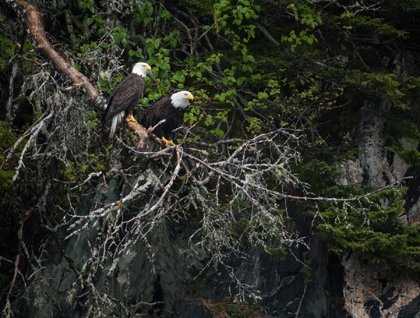Southeast Alaska’s “liquid sunshine” accompanied us as we sailed towards the Inian Islands, passing sea otters and the occasional Stellar sea lion, as humpback whale blows were spotted in the distance. Our first outings for the day began immediately after breakfast as we bundled up and into our fleet of expedition landing craft. These beautiful islands are rich with wildlife. We watched Steller sea lions as they glided effortlessly through patches of waters roughened by tidal currents moving through these narrow channels. They seemed to be curious of us, sneaking peeks at us, but losing interest quickly. These forceful Pacific tides create upwellings that make these waters very productive for wildlife. We had great views of bald eagles perched on a rocky hillside above us, while some boats had close-up views of humpback whales. Sea otters were found among the kelp beds, including some wonderful moms with their kits. Several types of seabirds were observed, including a few pigeon guillemots, and plenty of glaucous-winged gulls, pelagic cormorants, and black-legged kittiwakes.
After a short repositioning to Fox Creek, we set out for our afternoon activities from shore—walks and kayaking. Some folks stayed aboard exploring different options for their enjoyment including watching humpback whales from the ship, relaxing, reading, or reviewing photos. The “photo meanderers” walked along the beach first, then moving up into the grassy berm. Here, bright greens dominated the grayness of the day with unfurling ferns, the big new leaves of cow parsnip, and wild violets in bloom all heralding the arrival of summer. Along the beach and in the lush forest we found many signs of the local brown bear population—scat, crushed mats of plant material, freshly turned rocks, the exposed nutritious roots of skunk cabbage, even a few claw marks in the trees.
When everyone was back on board, we pulled anchor and headed eastward into scenic Icy Strait for closer views of the whales that had been spotted from the ship. Thus began another great late afternoon among whales, certainly a favorite time for everyone. While humpback blows had been seen all day at various distances, now killer whales were also spotted ahead. Following a stepping stone pattern of fluke-prints off the bow, we could easily track the next humpback surfacing ahead of the ship. We had humpback whales at “9 o’clock” with one humpback who surfaced right next to the boat, and raised its flukes to dive no more than 20 feet away. Meanwhile we had killer whales at “3 o’clock,” an active group of 10-12 animals. After some time comparing saddle-patch ID photos, Jack Swenson determined that this was a group of “transient” killer whales, those that specialize in targeting marine mammals as their primary food source, as opposed to the “resident” types who eat fish exclusively. Recap was delayed, and then delayed again, and finally abandoned as humpback and killer whales continued to surface giving us excellent views from the National Geographic Sea Lion.
Wow, another excellent day in SE Alaska.







